You have a wonderful idea for a story. Maybe it’s a mystery novel, a children’s middle grade story, or a picture book. Maybe it’s a young adult. You know what you want to say, or convey, and you start typing away. This is the beginning of every story.
But, we should backtrack a moment and go back to the idea. The idea: your protagonist has a problem or conflict. Delving a little deeper, you can see how each chapter or section will be worked out.
You are sure you can bring your idea to full fruition—without the use of an outline. Okay, that’s fine. Many writers use the by-the-seat-of-your-pants (pantser) writing method. So, off your mind and fingers fly . . . creating something from nothing . . . well, not exactly from nothing, from an idea.
This is the beginning.
You type a draft of your story. How long this process will take depends on how long your manuscript will be—whether a novel, short story, or children’s story. Take note though . . . even if your story is as short as a children’s picture book, you still need focus in your writing.
Writing Focus
Focus is the path from point A to point B. It’s the path from beginning to end that keeps the story together and wraps it neatly up.
An example might be an ice skater whose goal is to become good enough to get into the Olympics. His focus will be to train vigorously to accomplish his goal.
Another example might be that of a school bus on its route to pick up children and bring them to school. The shop is where the bus begins, point A; it will end up at the school, point B. But, between point A and point B, the bus must deviate from the direct path to pick up each child.
The same holds true for your story. There is a path the story needs to follow to accomplish its goal. If you deviate too much from this path your story becomes diluted or weak. This is not to say you cannot have subplots, it means everything needs to be tied together moving forward on the same path toward the same end.
Using an outline can often help with maintaining focus, even with a short story. It’s kind of a writing GPS that guides you from point A to point B. It allows you to stray here and there with the comfort of knowing that you need to be at certain points throughout the manuscript. It’s a reminder to keep you focused.
WANT TO BE A CHILDREN’S WRITER?
Check out my 200+ page ebook (or paperback) that gives you all the basics of HOW TO WRITE A CHILDREN’S FICTION BOOK. It’s newly revised and includes information on finding a publisher or agent and marketing your books.
MORE ON WRITING FOR CHILDREN
Writing to Get Published – 5 Power Tips
The Author Website – Keep It Simple and to the Point
Writing a Book – To Traditionally Publish or To Self-Publish


1 thought on “Writing with Focus”